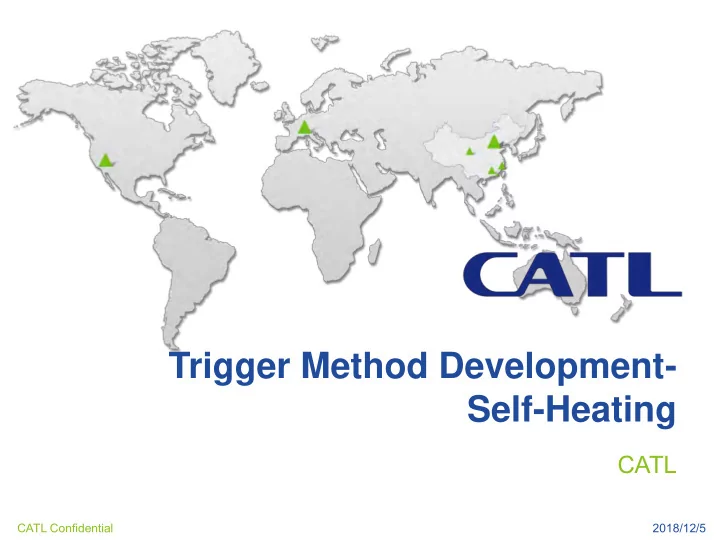

Trigger Method Development- Self-Heating CATL CATL Confidential 2018/12/5
Introduction The remarkable feature of this method is that there is no additional energy compared to a fully charged cell The purpose of this method is to use the energy discharged by the battery itself, heating a physical resistance to trigger the battery go to thermal runaway Easy for assembling Possible for automatic control … CATL Confidential Page 2 2018/12/5
Test Set Up : Self-Heating Method Test procedure(brief , see the attachment for details) : Module Assembly Switch Cell Switch on, start self-heating Switch off once thermal runaway Heat insulator between end-plate End plate and heater Heater The resistor we used in this Type Dimension Rated capacity Suitable cell 300~600w Metal insulated 130*90*3mm Pouch & Prismatic (approx. 5 w/cm 2 ) Proposed heater selection rule • The resistance sealed without “heated and flushed metal” exposure • Resistor selection: wouldn’t melt cell can/pouch package, and heating power should smaller than the continuous current interrupter that the cell can bear, but enough for thermal runaway Heater under initiation development • The heater should parallel to the cell surface, and similar area with the contacted cell surface is preferred, which wouldn’t lead additional gap between cell-cell or cell-end plate. CATL Confidential Page 3 2018/12/5 • …
Test Set Up : Self-Heating Method(Detailed Draft) Temperature: 25 ± 5 ℃ Voltage acquisition accuracy: ± 0.5mV Pre-condition • • • Humidity: 15%~90% • Atmospheric pressure : 86kpa~106kpa Resistance acquisition accuracy: ± 2m Ω • • Air condition: ≤10m/s Process • Connect the self-heating resistance with the initiation cell, which is from the positive electrode (or negative electrode) to the heating resistance, see Figure 1 • Any external wires need be acquired, which provides the way to charge the disperse units of the modified module. • Heating area of the self-heater is directly contacting the cell surface and it is not larger than the surface of that. • The heater position is correlated with the temperature sensor position, which is described in Figure 2. • The state of charge (SOC) shall be adjusted. • After installation, the self-heater should be reached to its fixed power, which depends on the energy of the battery pack. • Turn off the switch, when thermal runaway occurs. The temperature and voltage should be observed in period.. • The test shall be conducted at an indoor test facility or in a shelter to prevent the influence of wind. Module Switch Cell Heating resistance Heat insulator Temperature detection point between end-plate End plate and heater Fig1. Module modification Fig2. Schematic diagram of temperature sensor layout during heating Heater CATL Confidential Page 4 2018/12/5
Single Cell Test Result_ An Example Prismatic 5.0 800 Voltage Voltage T1 4.0 T2 600 Temperature Temperature( ℃ ) switch 3.0 Voltage(V) 400 2.0 cell R 200 1.0 Heat insulator Jig 0.0 0 0 600 1200 1800 2400 3000 3600 Time(s) CATL Confidential Page 5 2018/12/5
Energy Transformation Q : Energy release before cell thermal + - 𝑢1 𝑗𝑒𝑢 runaway , 𝑅 = 0 Q b : Total Energy absorbed by the heating Switch 𝑈1 𝐷 𝑞 − ℎ ∗ 𝑛 ℎ ∗ 𝑒𝑈 resistance, 𝑅 𝑐 = R 𝑈0 Q c : Dissipated heat with the environment, Q c = 𝑈1 ℎ ∗ 𝐵𝑒𝑈 , h=5 W/(m 2 *K) 𝑈0 Q d : Radiant Energy, Q d =ε*A*σ*(T 1 4 -T 2 4 ), σ=5.67*10 - 8 W/(m 2 *K 4 ) Sample Q(kJ) Q b (kJ) Q c (kJ) Q d (kJ) (Q b +Q c +Q d )/Q Example ~198.4 ~5.1 ~2.3 ~1.9 ~4.7% CATL Confidential Page 6 2018/12/5
Module Level Test Result_ An Example Prismatic module-1 1P4S Module Switch Cell Heat insulator between end-plate End plate and heater Heater Triggered cell : ~95%SOC Measured data include : Cell and module voltage Bottom temperature of the cell Photographs before , during and after the test CATL Confidential Page 7 2018/12/5
Demo Pack Test Result_ An Example Thermal runaway propagated to the other cells. Temperature 20.0 800 Voltage 16.0 600 Module Voltage(V) Temperature( ℃ ) Switch 12.0 400 V-Module 8.0 T1 T2 T3 200 T4 T3 T2 T1 4.0 T4 Heater 0.0 0 0 600 1200 1800 2400 3000 3600 Time(s) CATL Confidential Page 8 2018/12/5
Summary Draft heater selection rules have been proposed No additional energy during the Self-Heating test , and most of the energy(normally <5% heat capacity effect and heat dispersant) is re- entered into the battery by Self-Heating; We will continue to study the method, including heater development, procedure standardize and automatic control switcher etc. CATL Confidential Page 9 2018/12/5
感谢聆听 Web: http://www.catlbattery.com E-mail: sales@catlbattery.com
Recommend
More recommend